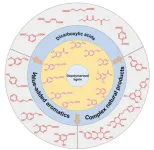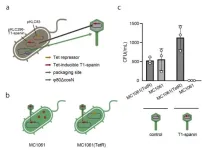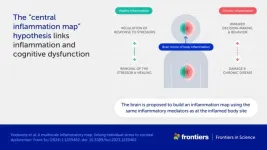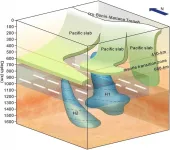(Press-News.org) A study links a rise in a serious bacterial illness to an unexpected factor: a decline in air pollution. Legionnaires’ disease is a respiratory illness with a fatality rate of 10–25% that is caused by inhaled Legionella bacteria. The bacteria live in water and outbreaks have been linked to water sources such as cooling towers, which cool indoor spaces by dissipating heat into the atmosphere in the form of water droplets and vapor. Other sources include improperly maintained public fountains, hot tubs, ice machines, home humidifiers, and showers. A global rise in Legionnaires’ disease since the year 2000 has puzzled experts. In the United States, reported cases of Legionnaires’ disease increased from 1,100 cases in 2000 to nearly 10,000 cases in 2018. Fangqun Yu, Arshad Arjunan Nair, and colleagues link the increase to a decline in sulfur dioxide (SO2) air pollution. Airborne water droplets carrying Legionella bacteria uptake SO2 from the ambient air, which can make the water droplet acidic and inhospitable for the bacteria when SO2 levels are high. As SO2 pollution declined nationally, the bacteria lived longer in airborne droplets, increasing the chances that viable bacteria could end up in a person’s lungs. According to the authors, reducing SO2 pollution has many well-established health benefits and should not be discouraged, but public health officials and clinicians should be aware of the potentially increased risk for Legionnaires’ disease.
END
Rising incidence of Legionnaires’ disease due to cleaner air
2024-03-12
ELSE PRESS RELEASES FROM THIS DATE:
You didn’t see it coming: the spontaneous nature of turbulence
2024-03-12
We experience turbulence every day: a gust of wind, water gushing down a river or mid-flight bumps on an airplane.
Although it may be easy to understand what causes some kinds of turbulence — a felled tree in a river or a bear splashing around for salmon — there is now evidence that a very small disturbance at the start can have dramatic effects later. Instead of a tree, think of a twig — or even the swerving motion of a molecule.
University of California San Diego Chancellor’s Distinguished Professor of Physics Nigel Goldenfeld, along with his former student Dmytro Bandak, and Professors Alexei ...
Advancing plant biology with breakthroughs in single-cell RNA sequencing
2024-03-12
Recent breakthroughs in single-cell RNA sequencing (scRNA), such as the recently developed “RevGel-seq” method, has revolutionized plant cell analysis. This technique, independent of special instruments, streamlines processes and resolves protoplast isolation challenges. Now, a multinational team of researchers review this and other such recent advances in plant scRNA sequencing with the intention of providing guidance for facilitating the appropriate selection of scRNA methods for different plant samples.
In the world of plant biology, understanding ...
Study provides new insights into deadly acute respiratory distress syndrome (ARDS)
2024-03-12
MINNEAPOLIS / ST. PAUL (03/12/2024) - Researchers at the University of Minnesota Twin Cities may have discovered a mechanical explanation for instability observed in the lungs in cases of acute respiratory distress syndrome (ARDS), particularly in the aftermath of respiratory illnesses such as COVID-19 or pneumonia.
The research was recently published in the Proceedings of the National Academy of Sciences (PNAS), a peer reviewed journal of the National Academy of Sciences.
Currently, there is no known cure for ARDS, a life-threatening ...
Valorization of depolymerized lignin using microorganisms
2024-03-12
Lignin is an abundant natural polymer which is eliminated as a byproduct in the pulp and paper industry. A recent review article explored different microbial processes available for sustainable lignin valorization, yielding not only environmental, but also economic benefits. Researchers highlighted the current advancements as well as challenges faced while using naturally occurring and engineered microbes to transform depolymerized lignin into valuable high-value products.
The increasing focus on transitioning to a low-carbon ...
Exploring the bactericidal activity of T1-spanin against drug-resistant bacteria
2024-03-12
Given the worldwide prevalence of drug-resistance bacteria, the research fraternity is on the lookout for alternative bactericidal treatment approaches. In a recent study, Japanese researchers have now compared bacteriophage-derived enzymes for combating drug-resistant bacteria. Examination of T1-spanin revealed that it shows superior bactericidal activity against various strains, including E.coli. Furthermore, a novel phage-based technology effectively delivers T1-spanin genes into target bacteria. This breakthrough holds promise for the development of ...
Chronic stress and inflammation linked to societal and environmental impacts in new study
2024-03-12
From anxiety about the state of the world to ongoing waves of Covid-19, the stresses we face can seem relentless and even overwhelming. Worse, these stressors can cause chronic inflammation in our bodies. Chronic inflammation is linked to serious conditions such as cardiovascular disease and cancer – and may also affect our thinking and behavior.
A new hypothesis published in Frontiers in Science suggests the negative impacts may extend far further.
“We propose that stress, ...
Rice paddy snake diversification was driven by geological and environmental factors in Thailand, molecular data suggests
2024-03-12
LAWRENCE, KANSAS — A University of Kansas study of rice paddy snakes in Southeast Asia gives key details to their diversification and natural history, adding molecular evidence that the rise of the Khorat Plateau and subsequent environmental shifts in Thailand may have altered the course of the snakes’ evolution some 2.5 million years ago. The findings were published today in the journal Scientific Reports.
Researchers say the implications could help tell the story of diversification more broadly in the region.
“This paper concerns mud snakes ...
Mars attracts: How Earth’s interactions with the red planet drive deep-sea circulation
2024-03-12
Scientists from the Universities of Sydney and Sorbonne University have used the geological record of the deep sea to discover a connection between the orbits of Earth and Mars, past global warming patterns and the speeding up of deep ocean circulation.
They discovered a surprising 2.4-million-year cycle where deep currents wax and wane which, in turn, is linked to periods of increased solar energy and a warmer climate.
The study, published in Nature Communications, tackles the questions of how geological-timescale climate ...
The surprising effect of presence hallucinations on social perception
2024-03-12
If you had to estimate the number of people in a room, without counting them one-by-one, by nature you would overcount them. That’s because, simply put from a Darwinian perspective of how we have evolved, it’s better to overcount potentially harmful agents and predators than to underestimate them. This overcounting social behaviour is shown to be true in humans as well as animals. It’s certainly better to detect too many tigers (even if absent) during a jungle excursion than to miss a hungry one!
Now, EPFL neuroscientists show that if you experience hallucinations, especially ...
Seismological study shows ancient lower mantle flow field under Philippine sea plate
2024-03-12
Researchers from China and Japan have discovered distinct characteristics of the lower mantle flow field. They investigated seismic anisotropy in the upper part of the lower mantle beneath the Philippine Sea Plate (PSP) and found that the ancient lower mantle flow field is still preserved there.
The study was published in Nature Geoscience.
The lower mantle is an important layer of the Earth and may play an important role in the evolution and material cycling of Earth's interior. It is generally believed to be not only the final destination of subducted slabs, ...







